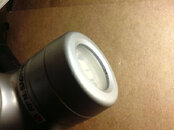Pao
Contributor
I just had my 3 yr old reg (Apeks ATX100) serviced. It has an environmentally sealed 1st stage with an external and an internal diphragm. I noticed that the external diaphragm is slightly bulging. It is usually concave even if attached to a tank with the valve open. Is this normal? I asked the technician and he said that this was normal and he tested the reg after service and found no leaks. I am alittle concerned and am wondering if air may be leaking into the isolation chamber between the diaphragms which may cause freeflow. Any similar experiences/advice?
Thanks in advance.
Thanks in advance.






